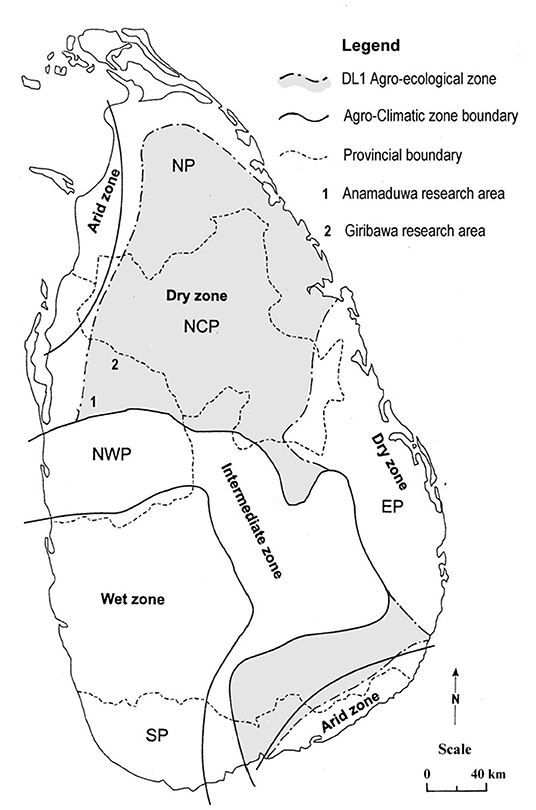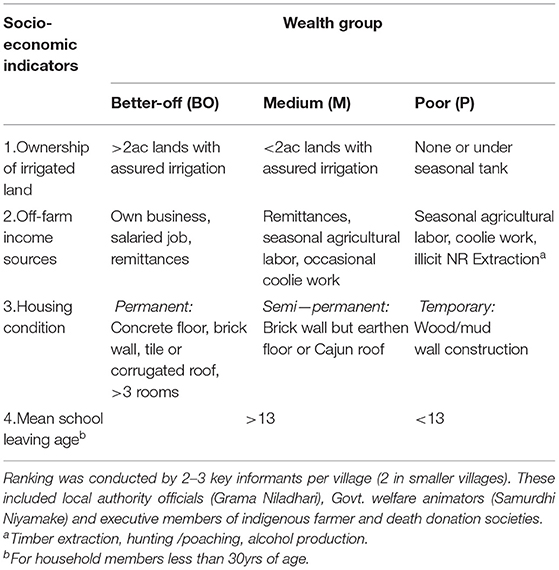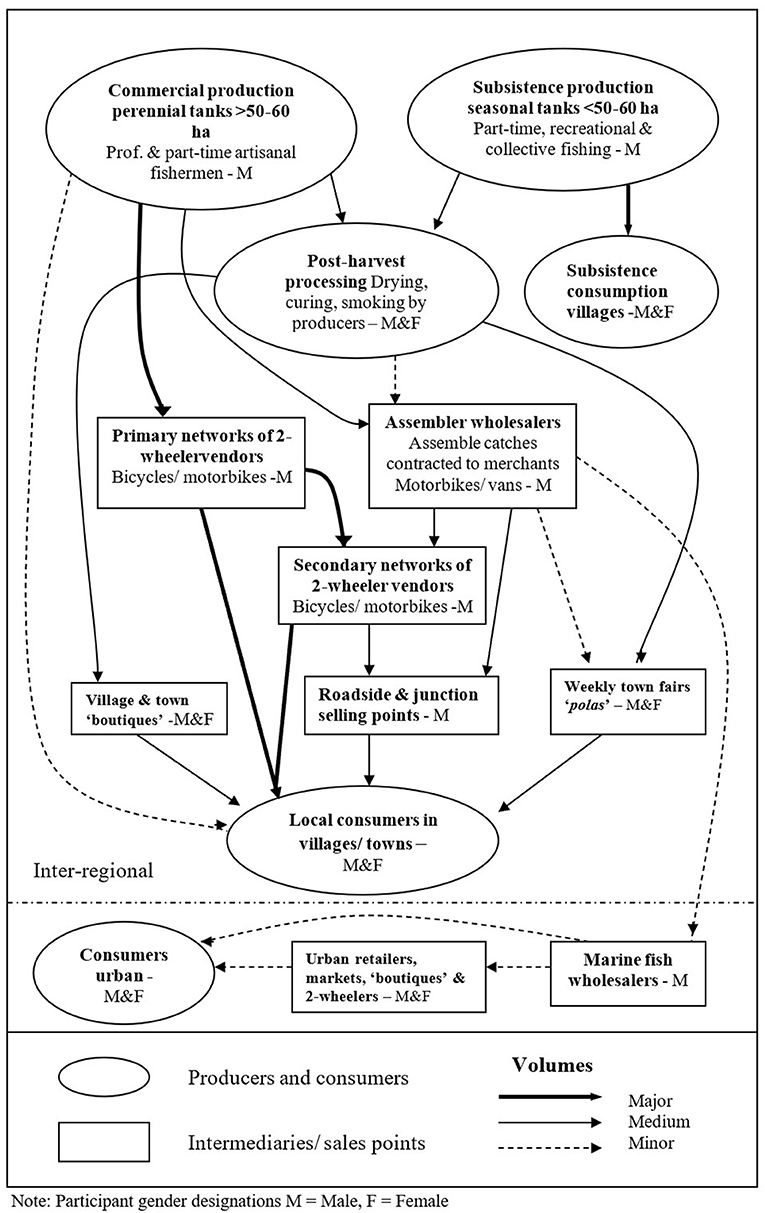- Faculty of Natural Sciences, Institute of Aquaculture, University of Stirling, Stirling, United Kingdom
Poor understanding of market demand is a key factor in the recurrent failure of many production-orientated aquaculture interventions. In the Dry-Zone of Sri Lanka stocking-based fisheries enhancements in small-scale reservoirs have been promoted by the State since the 1980's with no evidence of sustainable adoption. Through an evaluation of positive (actual) and normative (aspirational) consumer preferences for inland fish and its substitutes, we aimed to assess underlying reasons for this recurrent failure and future prospects for the policy and rural food-security. Work commenced with a detailed scoping-analysis to establish socio-economic context and a sample frame for systematic surveys. Consumption recall and preference ranking/scoring techniques were applied in two iterative survey phases across 6 villages of Northwest Province. Totals of 39 and 165 respondents were surveyed across the two phases with selection stratified on age, gender, caste and wealth criteria. Results underscored the importance of inland fish to rural food security. Fresh inland fish was consumed by 60% of all respondents at least once per fortnight and by 82% at least once per month with tilapias accounting for 75–85% of meals. Preference for inland fish compared over similarly priced substitutes is attributable to their freshness at point of sale above any other intrinsic product quality. Larger inland and marine fish were more popular than smaller sizes of the same varieties though poorer households consumed lower cost small fresh tilapia (<180 g) and dried marine fish at higher frequency. Common carp an exotic candidate for culture-based reservoir stocking enhancements, held an intermediate position. National policies on inland aquaculture development and rural food security are discussed and recommendations made in the light of these findings.
Introduction
Poor understanding of consumer preferences and linked supply and demand characteristics has been a significant factor in the failure of many production-focused commercial aquaculture start-ups and development interventions (Little et al., 2013). This study contributed to a wider action-research effort investigating how enhanced fish production in community-managed village reservoirs in the Dry-Zone of Sri Lanka might benefit the poor (Murray, 2004). Preliminary work on the marketing of inland fish and its substitutes (Murray and Little, 2000; Murray, 2006a) implicated the ready availability and low-cost of introduced self-recruiting tilapias as a key factor in the failure of historical attempts to promote integration of aquaculture in these systems. The study aimed to further evaluate reasons for this failure through an analysis of rural consumer preferences for fish and alternative protein sources. Critically, we assessed not only what different social groups normally eat, but also what they would aspire to eat and their perceptions of the underlying product attributes that shape these “positive” and “normative” outcomes. Based on these findings we assess government policies toward development of inland aquaculture and options for more sustainable aquaculture development approaches.
The Development Context
The lowland Dry-Zone covers nearly two thirds of Sri Lanka's land area. With few perennial rivers, low and erratic rainfall, historic settlement followed development on an extensive network of irrigation reservoirs. An estimated 20–30,000 small-scale “minor” village reservoirs (<1 to 10's of ha) are interspersed between smaller numbers of “major” reservoirs (mostly 100's to 7,680 ha in area). Colloquially described as tanks or wewa and generically as barrage-ponds, minor reservoirs consist of earthen dykes (with sluice gates and spillways) constructed across ephemeral streams.
Self-recruiting tilapias, Oreochromis mossambicus, first introduced in the 1950's. and more recently O. niloticus and their natural hybrids, proved well adapted to conditions in shallow Dry-Zone reservoirs, making them one of the most productive and resilient self-recruiting reservoir fisheries in the world (De Silva, 1988). Natural recruitment of fish stocks is facilitated through seasonal migrations between tanks, arranged in cascading sequence in gently undulating terrain. This allows repopulation of smaller seasonal tanks that periodically dry-out with complete loss of stocks.
In North West Province (NWP), the location of our field research sites (Figure 1), seasonal water deficits combined with favorable soils and relief correspond with one of the highest densities of minor and major reservoirs in the country (Sakthivadivel et al., 1997). Development of several large-scale modern irrigation schemes and rehabilitation of many ancient major reservoirs (De Silva, 1988) has occurred alongside a far more piece-meal renovation of smaller village tanks. This corresponds to two distinct patterns of recent settlement growth; one characterized by endogamous population growth within longer established so-called purana (literally old) communities around minor village tanks and another based on more heterogeneous settlement in small towns and service-centers (typically <20,000 persons) located around major irrigation systems in lower watershed areas (Kodithuwakku, 1997). In 2001, 82% of the population in NWP were of Sinhalese ethnicity, followed by Sri Lanka moors; mainly Muslim and Tamils; mainly Hindu with higher concentrations in towns and coastal zones (DCS., 2003). Purana communities are also characterized by their highly conservative endogamous relations; marrying within discrete social groups according to their ethnic and religious; predominantly Sinhalese-Buddhist and caste characteristics.
The physical and social and characteristics of these multiple-use irrigation resources has given rise to two distinctive capture fisheries; (i) year-round artisanal production from larger perennial reservoirs under co-management or open-access conditions, and (ii) seasonal subsistence production from communal rain-fed village tanks (Murray, 2006b).
Despite advances in health-care and education, malnourishment remains a persistent problem in rural Sri Lanka. The prevalence of stunting in under-5 children remained relatively constant, fluctuating between 12 and 20% and averaging 17.3% between 2000 and 2016 (more severe wasting averaging 4%), whilst around 21% of children consumed <31 g of protein per day in 2010 (Weerahewa et al., 2018; WHO, 2019). WFP reported a 15% prevalence rate of wasting in children from 0 to 59 months in 2016 with the highest rates in Dry-Zone rural Districts. In a 2016 survey of 1,012 school children in Northern Sri Lanka, Sathiadas et al. (2021) recorded stunting and wasting in ~12 and 30% of cases respectively.
Needham and Funge-Smith (2014) estimated that marine species accounted for 81% of total fish consumption in the country. However, inland fish production is significantly under reported in in many low-income settings (Fluet-Chouinard et al., 2018). The contribution of the reservoir fishery to rural food-security is reinforced by marked demarcation between urban and rural demand; marine fish predominating in cities and coastal locations and reservoir fish in rural areas (Murray et al., 2000). Whilst tilapias contribute to subsistence harvests from both major and minor village tanks, it has been the economic incentives provided by the tilapia fisheries in the major reservoirs that have normalized participation in commercial fishing (Murray et al., 2000).
As more affluent urban areas transition to the “fourth stage of nutrition” (i.e. from more vegetable-based diets to processed foods with added fat, sugar, salt and animal foods as sources of energy, protein and fat), Sri Lanka faces a “double burden of over and under-nutrition” (Weerahewa et al., 2018; Renzella et al., 2020). Small rural communities in remoter upper watersheds, many of lower-caste status and the focus of this research, continue to face the greatest hardships associated with seasonal water scarcity and other resource constraints evidenced by persistently high chronic malnutrition indicators including infant stunting and wasting (Murray, 2004; Sathiadas et al., 2021).
This transitional nutrition context and potential for receding rural famine to influence revealed preference outcomes were the basis for development of the conceptual framework shown in Figure 2; which in turn shaped consumer survey instrument and sample design. Watershed location, caste status, age and gender were envisaged as moderators of wealth and well-being at community (village) at household and intra-household levels, and product cost and attributes (size, taste, fresh v dried) as mediator variables with potential to influence positive and normative preference outcomes. Ethnicity and religion served as control variables consistent with their uniformity across the study's focal development context.
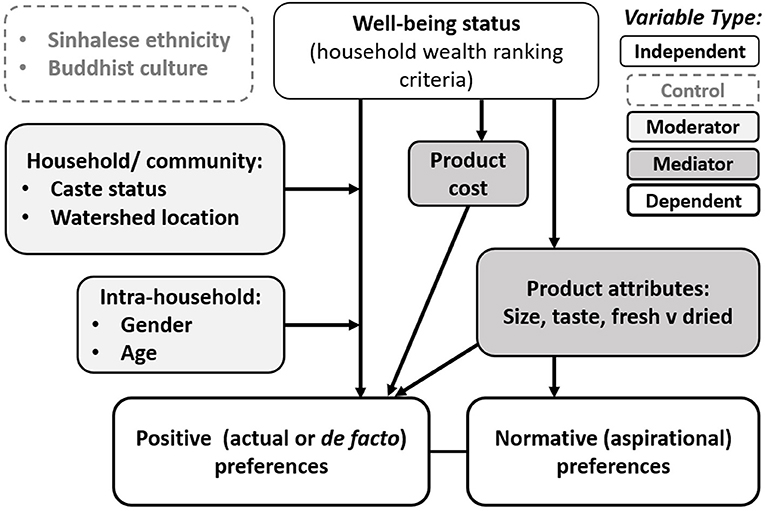
Figure 2. Conceptual framework for phase 1 and 2 consumer preference surveys for inland fish and their substitutes, Northwest Province, Sri Lanka.
Materials and Methods
An exploratory-sequential mixed-methods approach was adopted to enhance external validity, (Creswell, 2014). The study was part of a longer term (4 year) action-research project that assessed the importance of inland fish for 31 communities accessing 94 minor tanks in 21 watersheds and their related value chains within four Dry-Zone provinces (Murray, 2004). This facilitated characterization of the social categories deployed as independent variables in this study.
Over the course of two iterative research phases, consumer attitudes toward fish and meat consumption were tested in a total of six villages in the adjacent districts of Puttalam and Kurunegala of NWP (Figure 1). Two of the villages were selected for an exploratory phase (1), followed by a larger systematic survey of the four remaining villages (Phase 2, Table 2). Phase 1 included a wealth-stratified systematic survey of household food consumption and purchasing habits (n = 32) enabling assessment of concurrent validity (Messick, 1995) with preference ranking outcomes. Questions focussed on the frequency and seasonality of consumption of major food groups by individual household members. A single preference ranking/scoring question in phase 1 helped delineate preference attributes and was the basis of four ranking questions developed in phase 2 (Table 4).
Sample Design
The six study villages were selected to be as uniform as possible with respect to their access to primary seafood production sources and markets, being 30–40 km from the coast, 10–15 km from the nearest small-service Center and commercial reservoir fishery. All were “rain-fed” purana villages with known settlement history ranging from 50 to over 200 years with a 100% Sinhalese /Buddhist ethno-religious composition; individual communities consisted of endogamous kinship groups of uniform caste. Within this setting the different communities incorporated a range of physical and social variability, with hypothetical potential to influence seafood preferences (Table 1, Figure 2).
Two larger, higher caste villages (DDW and PDW; Table 2) located in mid to lower watershed areas were the focus of phase 1, whilst phase 2 shifted to four smaller (<52 households), low-caste, upper watershed communities.
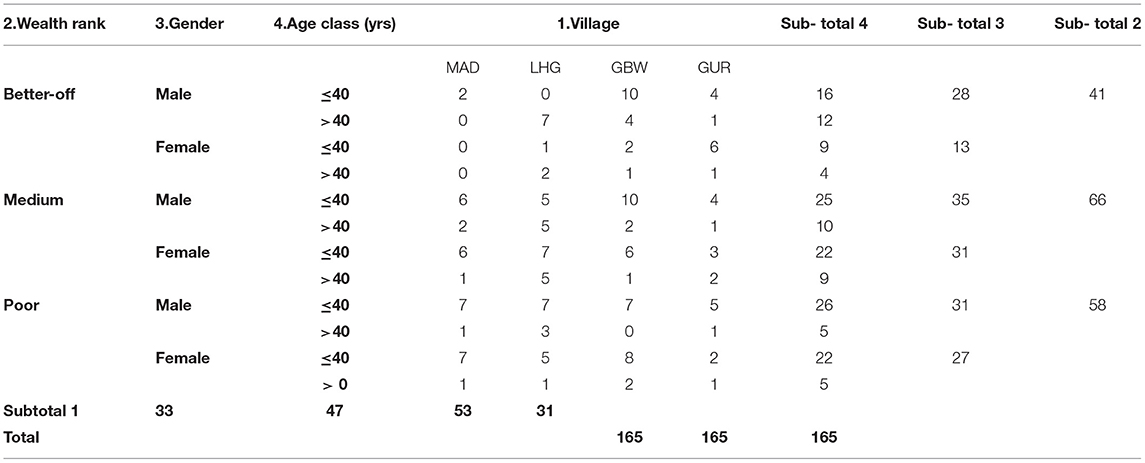
Table 2. Phase 2 sample-design with respondent numbers cross-tabulated against four background variables.
Randomized selection of respondents was stratified on four independent variables; watershed location and wealth-status in phase 1, whilst in phase 2, gender and age variables were also added to permit intra-household assessments (Table 2). Participants were aggregated into two age cohorts; ≤ 40 years and > 40 years, based on an age-related adherence toward more conservative religious prohibitions on seafood production and consumption observed in the phase 1 scoping survey. Wealth ranking exercises were conducted with multiple key informants (2–3 per village: Table 3), and any ranking inconsistencies resolved through household visits (Murray, 2004). To ensure comparability of outcomes, all ranking exercises were conducted using four indicators consistently identified by the key informant group as a whole (Table 3). The wealth status of every household in each village was then plotted on social maps. These censuses then became sample-frames for stratified-random sampling.
In each phase equal sampling effort was distributed within spatially delineated clusters of 10 to 20 households (contingent on the size of the village). An initial attempt was made to interview broadly similar numbers of respondents within wealth categories in a balanced-design, though ultimately 30–38% more “poor” and “medium” than better-off respondents were interviewed reflecting a highly skewed underlying population distribution. Unbalanced sample numbers on other criteria (village, gender, and age strata) were secondary outcomes of this strategy and rejection of responses of several female respondents biased by persistent male interruptions.
As phase 2 was implemented during the main maha rice-harvest season (Figure 4), most interviews were conducted in the early evening when villagers were at home. Group settings were avoided as far as possible to preclude response-bias through the influence of dominant household members or other individuals.
Preference Ranking and Scoring Techniques
Scoring and ranking techniques were adapted from methods described by IIED. (1993) and Gosling and Edwards (1995). All ranking and scoring (RS) questions (Table 4) and methods were pilot-tested, refined and an exhaustive inventory of response criteria elicited through focus group and key informant interviews in adjacent villages.
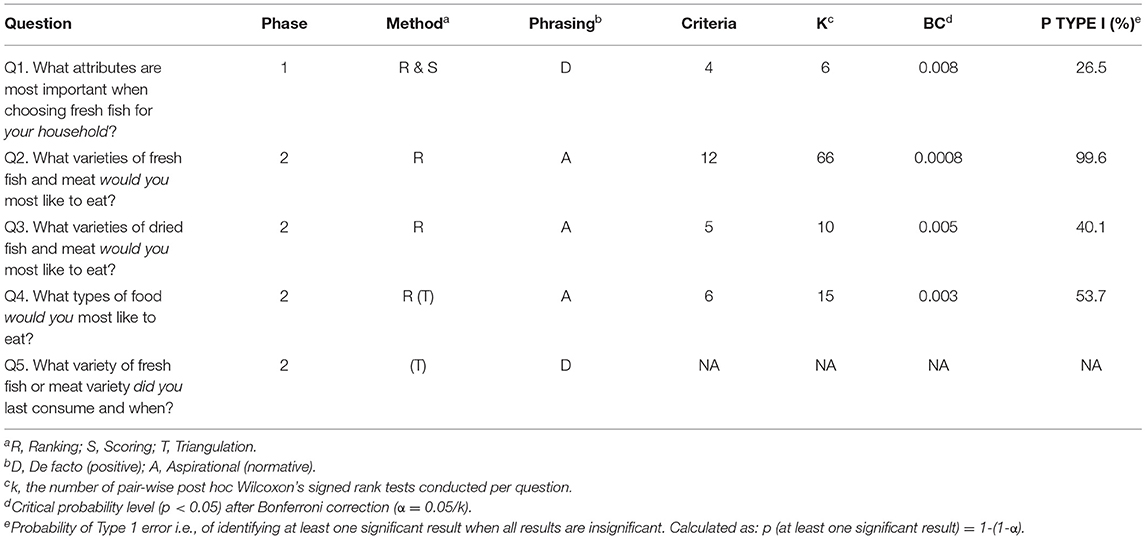
Table 4. Characteristics of preference ranking, scoring and triangulation questions employed in phases 1 and 2 and family-wise error rates for pair-wise post-hoc tests.
Phase 1 respondents were asked to rank (and score) the characteristics of fresh fish that influenced their household purchasing and consumption habits based on four elicited attributes: cost, quality, size and taste (Table 5). In contrast, phase 2 respondents were asked to reflect specifically on their own personal preferences i.e., rather than acting as key informants for their entire household as in phase 1. A second difference lay in the supplementing of positive (de facto) with normative (aspirational) phrasing, whereby phase 2 respondents were also being asked to think beyond reasons for their existing consumption habits.
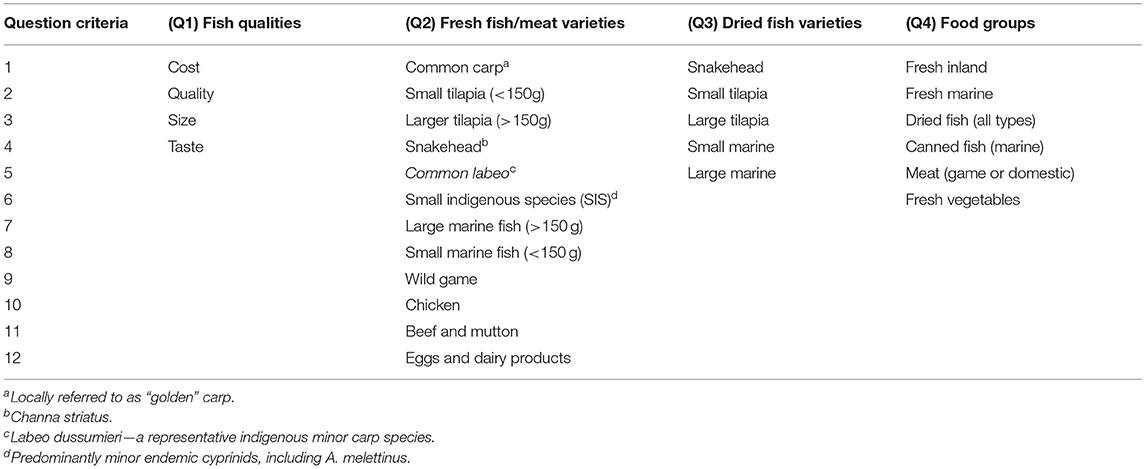
Table 5. Inventory of food preference criteria elicited for phase 1 and 2 scoring and ranking exercises.
Based on results of the phase 1 “attribute” question, two phase 2 questions were evolved. This time respondents were first asked to rank varieties (variously distinguished by species, size and production source) of fresh inland fish and their substitutes (Table 4, question 2) followed by varieties of dried fish; fresh water and marine (question 3) that they would like to eat. Questions 4 and 5 provided triangulation checks on response logical consistency whilst still in the field. Food types ranked in question 4 were aggregates of varieties specified in questions 2 and 3 i.e., different forms of fish (dried, fresh or canned) as well as other generic substitutes (meat and vegetables).
Two scoring methods were evaluated during phase 1 piloting. Respondents were first asked to adopt a fixed scoring regime using 12 mung beans as counters (3 times the number of criteria elicited for question 1), which they divided between the specified criteria. However, most respondents found it much easier to score individual criteria out of an identical number of points, this time on a scale from 0–10 (in each case higher scores signified higher preference levels). However, this method became increasingly cumbersome and reproducibility declined as criteria numbers increased. A common response is to aggregate criteria based on shared characteristics. Here we evolved a “rapid pair-wise ranking” (RPR) technique, from a much more time-consuming pair-wise matrix ranking method (IIED., 1993) involving comparisons of all factorial criteria combinations.
In our RPR method, respondents were first asked to select their most and least preferred criteria from the full list of options. These were then removed from the list and the process repeated until all criteria had been excluded. To expedite the process, possible responses were written on separate cards alongside pictorial representations of the foods. The first pair were assigned ranks of 1 (best) and 12 (worst), the second pair 2 (next best) and 11 (next worst) and so on. Matched preferences for multiple-criteria were assigned average or split-ranks. Using this method up to 12 criteria were addressed in a single question (phase 2, question 2; Table 5). This far exceeded the maximum of six recommended to achieve reasonable logical consistency and reproducibility by Gosling and Edwards (1995) and Maxwell and Bart (1995). The rapid and conceptually straightforward nature of the RPR method also helped maintain participant concentration and thereby accuracy.
In both survey phases results were summarized and participants invited to review and if necessary, adjust their responses. Finally, respondents were invited to give reasons for their overall preferences. This last step proved an important means of assessing content validity (Pennington, 2003) relating to the appropriateness of ranking and scoring in measuring food preferences in the given context.
Statistical Analysis
Non-parametric Friedman's two-way within-subjects analysis of variance by ranks (SPPS version 10) was used to evaluate whether different consumer groups (Table 2) exhibited significantly different food preferences (questions 1–4). Significant outcomes (p < 0.05) were followed up by pair-wise comparisons using Wilcoxon's signed ranks test. A sequence of tests was run first on the entire set of respondent responses for questions 1 to 4 and subsequently on respondent sub-groups defined by the stratification variables used in each phase. Preferences were then re-ranked based on the outcomes of all combinations of pair-wise tests (Tables 5–7). Superior ranks, 1 being highest, indicate significantly greater preference (Wilcoxon's test, p < 0.05) than for all criteria with inferior ranks (minor exceptions indicated in Table 8, resulted from high standard deviations in the original mean rank order). Any tied criteria in the new ranking outcomes were reassigned split ranks.
The critical p-value (α; we used an initial value of 0.05), was further adjusted using the conservative Bonferroni correction method calculated as: α = 0.05/k where k = the number of independent tests (Table 4).
Results
Results of the local value chain assessment and phase-1 survey of consumer habits are summarized before presenting phase 1 and 2 ranking and scoring exercise outcomes.
Seafood Value Chain Characteristics
Within the research area, several larger perennial water bodies (>200 to 3,000 ha) are the mainstay of an artisanal commercial inland fishery, dominated by tilapias. Most of this fresh-caught produce is locally distributed on a door-to-door basis by an extensive network of “two-wheeler” (bicycle and motorbike) vendors marketing freshly caught, (Figure 3) to even the remotest rural areas without icing or refrigeration. Very little of this harvest finds its way to larger urban markets (i.e., Kandy or Colombo) where demand is primarily for fresh marine fish distributed on ice. Marine fish is also sold from road-side selling points at busy junctions and in small towns in the research area together with lesser quantities of inland fish. Consolidation opportunities meriting use of vans and trucks (and ice) are limited to seasonal peaks in landings (Section Seasonal Supply and Demand) from assembly points around larger reservoirs. Due to erratic seasonal availability and greater risk of off-flavors (particularly for tilapias) most production from smaller seasonal tanks is destined for less quantifiable local subsistence consumption. Subject to these constraints, relatively small quantities periodically enter commercial pathways (Section Seasonal Supply and Demand). This combination of factors results in most inland fish being consumed within a range of up to 30–40 km from source of production.
In the absence of reliable refrigeration, dried fish, mainly marine is a dietary staple. Substantial quantities are sold at weekly open-air markets (polas) and are purchased from ubiquitous village “boutiques” (small general stores). At the time of research, surplus production; mainly of large tilapias and snakeheads from reservoirs in the war-depopulated northern Wanni region also found their way to these dried fish markets.
Seasonal Supply and Demand
The major climatic and livelihood factors affecting seasonal demand and supply of inland fish and its substitutes in the research area are summarized in Figure 4. Production peaks occur during two dry seasons associated with a bimodal monsoonal rainfall distribution (Mar-Apr and Jul-Sep) when reductions in water spread and depth increase the susceptibility of all species to the gill net fishery. Highest production and lowest prices occur during the main dry season (Jul-Sep), with harvests rising and falling faster in progressively smaller reservoirs. As water levels fall, catch per unit effort (CPUE) increases to a point where stocks finally become limiting contingent on water-body characteristics and the duration/severity of the dry-season. Large exotic common carp (Cyprinus carpio), relics of culture-based stocking programmes in perennial reservoirs, were most plentiful with the onset of rains as elevated turbidity levels cause them to rise and become more susceptible to the gill-net fishery. In contrast, high value bottom-dwelling snakehead (Channa striatus) become most accessible to a variety of gears during the dry season.
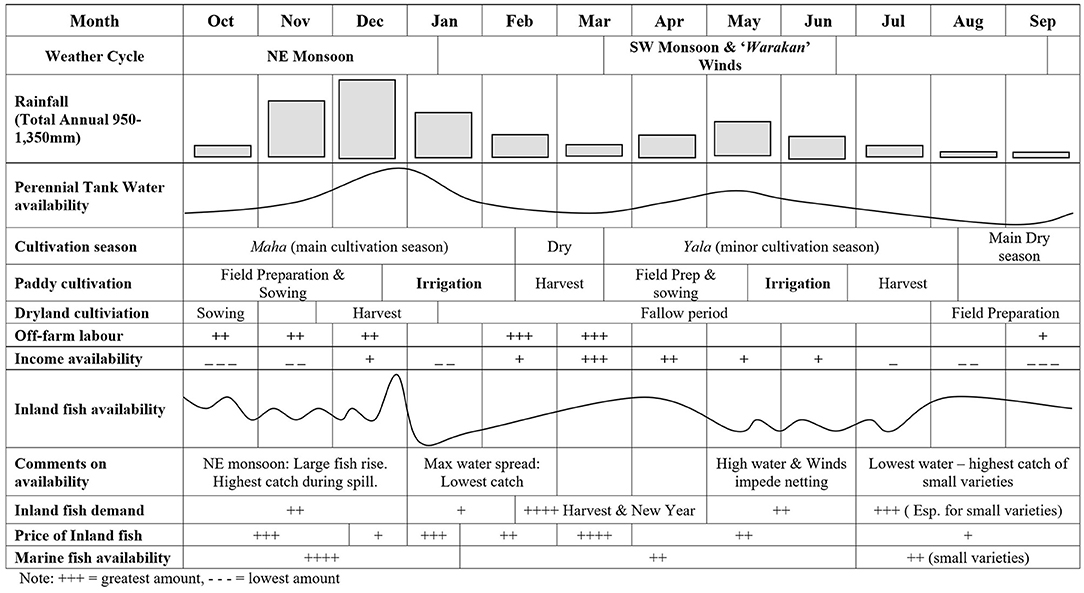
Figure 4. Seasonal livelihood calendar (farmers) and fish demand and supply trends, Galgamuwa and Anamaduwa Districts, North West Province. Source: Interviews with farmers, fish producers and vendors.
Complementary variation in the supply of substitutes and other rural livelihood factors means that compared to other food commodities, supply and demand for inland fish remains well matched and prices remain relatively constant throughout the year. Greatest demand for fresh fish occurs during the main maha agricultural harvests (Feb-Apr) corresponding with the minor dry-season peak in inland fish production when farming incomes are highest (Murray, 2006a). In-kind remuneration of seasonal agricultural laborers involved in harvesting commonly includes meals of fish and rice. Prices then briefly rise to their annual high as demand surges for several weeks over the Sinhalese Buddhist New Year celebrations. Highest supply and lowest prices occur during the dry season “hungry months” when the poor face greatest difficulty achieving basic food security. Small tilapias are so plentiful and prices so low at this time that the poor substitute them for vegetables, which become scarcer and more costly during the dry season. Fresh marine fish are most abundant and prices lowest, during the main rainy season (Oct to Jan). Smaller low-cost varieties; sardines and mackerel, both fresh and dried are relatively abundant during the dry season—complementing the modest supply of fresh inland fish at these times. Hook and line fishing and collective harvests from village tanks provide additional subsistence though off-flavor problems which become worse as stored waters recede, effectively preclude commercial sales.
Phase 1 Consumer Survey
Inland fish was the most frequently consumed type of fresh food of animal origin in the two phase 1 villages (PDW and DDW), being consumed on average by 60% of all respondents at least once per fortnight and by 82% at least once per month. Only better-off and medium wealth respondents regularly consumed fresh marine fish at least once per month as a substitute for more regular inland fish consumption. Poorer households were more likely to consume only fresh inland fish, at a lower monthly frequency. Dried fish was consumed on a similar frequency by better-off and medium wealth groups but more often by the poor, at a frequency of 2–5 meals per week. Whilst 0.5 kg of fresh fish was consumed in a single meal for a family of 4–5, the same weight of dried fish typically extended to 3–4 meals. Dried fish is also 2.5–3.5 times more concentrated than fresh fish as a protein source (Roos et al., 2003) yet costed on average only twice as much.
Tilapias accounted for 75–85% of fresh fish meals. Seasonally available large common carp specimens (Section Seasonal Supply and Demand) tended to be consumed on special family occasions (Section Major carps). Indigenous snakehead (C. striata) and green chromide (Etroplus suratensis) were frequently consumed but in smaller amounts. Other indigenous species including; climbing perch (Anabas testudineus), small catfish (Mystus spp., Heteropneustes spp.) and a variety of small indigenous cyprinid species (SIS) including A. melettinus, and several Puntius sp. (P. dorsalis, P. filamentosus, P. chola and Danio Equipinnatus) become more available, toward the end of the dry season.
On average, chicken, beef and pork were each consumed only once per month or less. Wild game, mostly venison and boar were as, or more popular than, other meat, and comparably priced.
A sizeable minority, mainly older and more affluent householders, abstained from consuming certain foods entirely; 7, 29, and 32% of all respondents (n = 82) avoided inland fish, marine fish and meat respectively. Most of these cases had previously consumed fish but given it up once they reached an age of 40–45 years citing increased religious observance.
Phase 1 and 2 Preference Ranking and Scoring Results
Totals of 39 and 165 respondents participated in the phase 1 and phase 2 surveys respectively. Collectively this represented 15% of the entire population of the six study villages, totalling 339 households (with a mean occupancy of 4 persons) and from 7 to 56% of individual village populations (Table 1). Table 5 shows the criteria used in each of the four ranking and scoring exercises.
Friedman's analysis of pooled scoring and ranking outcomes on questions 1–4 (Table 4), revealed the presence significant differences in preferences between different respondent groups as follows:
(Q1) fish choice characteristics (χ2 (3) = 78.3; p < 0.05, n = 39)
(Q2) fish and meat varieties (χ2 (11) = 633.6; p < 0.01, n = 165)
(Q3) dried fish varieties (χ2 (4) = 132.1; p < 0.01, n = 164)
(Q4) other food groups (χ2 (5) = 205.3; p < 0.01, n = 162)
Thus, differences were highly significant (p <0.01) in the case of all phase 2 questions (Q1–3). Based on pairwise testing outcomes (Wilcoxon's test; P < 0.05), Tables 6–8 map the locus of these differences against the four independent stratification variables deployed across the two study phases: village, wealth status, gender and age.
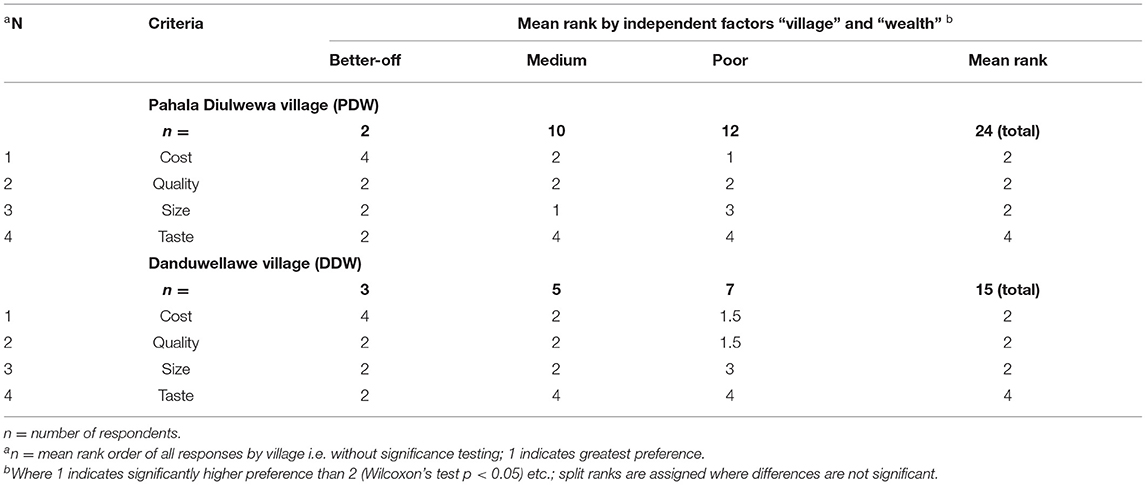
Table 6. Overall ranks from pair-wise tests on preference scores by “village” and “wealth” for question 1; “What do you look for in your choice of fish?”
Question 1 outcomes (Table 6) reflect similar attitudes in the two higher caste phase 1 villages; PDW and DDW. Generally, cost was more important to poorer than better-off groups. Taste, whilst marginally more important to the better-off, was assigned the lowest rank by most other respondents. Aside from the primacy of cost considerations, this may be because fresh fish is usually fried and/or curried.
Over the course of the analysis, it became evident that the question 1 “size” criteria, achieved a rather indeterminate position as it interacts positively with “cost” and negatively with two further criteria which emerged only once the exercise was underway; “processing losses” and “boniness.” As previously noted, poorer people consumed more small fish because of its lower cost, however some respondents observed there was less wastage from larger fish, whilst other families were reluctant to feed young children smaller tilapia because of their relatively high bone content. These interactions obscured other differences; i.e., whether and why “size” preference was for small or large fish, leading to the disaggregation of varietal criteria in phase 2.
Better-off respondents were under-represented in phase 1; however, phase 2 results (questions 2, 3 and 4) indicate a broad degree of consensus in normative preferences on varietal attributes (Table 7). Overall, larger locally harvested varieties of fresh fish were most popular i.e., large tilapia followed jointly by snakehead (and wild game). Chicken held an intermediate position along with major carps, whilst beef and mutton with a mean rank of 10.5 proved least popular. Fresh marine fish varieties were significantly less popular than inland varieties and small-sized fish were less popular than large size-fish in both cases. Small indigenous cyprinid species were the least popular of all fresh fish (mean rank 8.9). Dried fish (question 3) also fell into two size-related preference categories. Most popular were large dried varieties irrespective of source (large marine, tilapia and snakehead), whilst small varieties were again least popular, despite recording the highest consumption frequency of all varietal categories by poorer respondents.
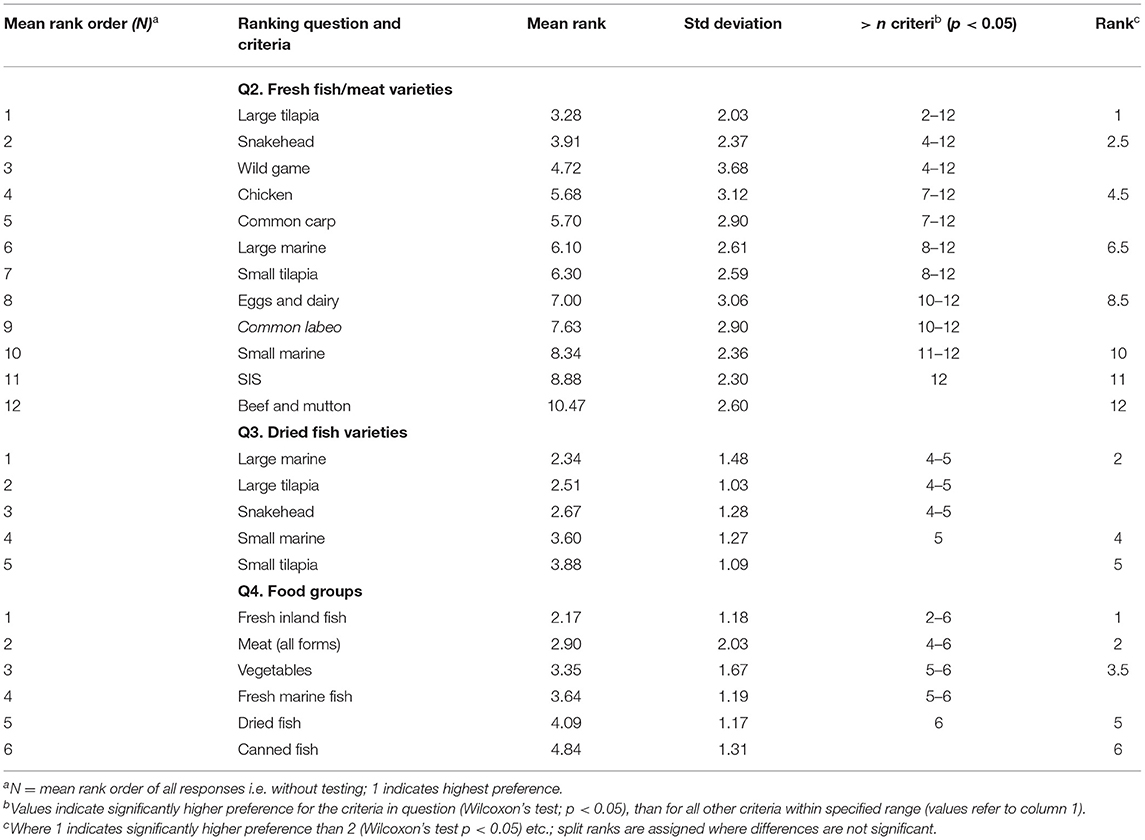
Table 7. Overall ranks and descriptive statistics from pair-wise tests on preference ranks for all responses to questions 2, 3 and 4.
Differences in the preferences of better-off and poorer consumers were generally consistent between villages (Table 8). Fresh marine varieties were relatively more popular amongst better-off than poor respondents and small tilapias more popular with medium and poor respondents. Large dried marine fish proved more popular than large dried inland fish among better-off and older (>40 yrs) people (Q3). However, fresh inland fish consistently proved the most, or jointly most, popular food type amongst all consumer groups.
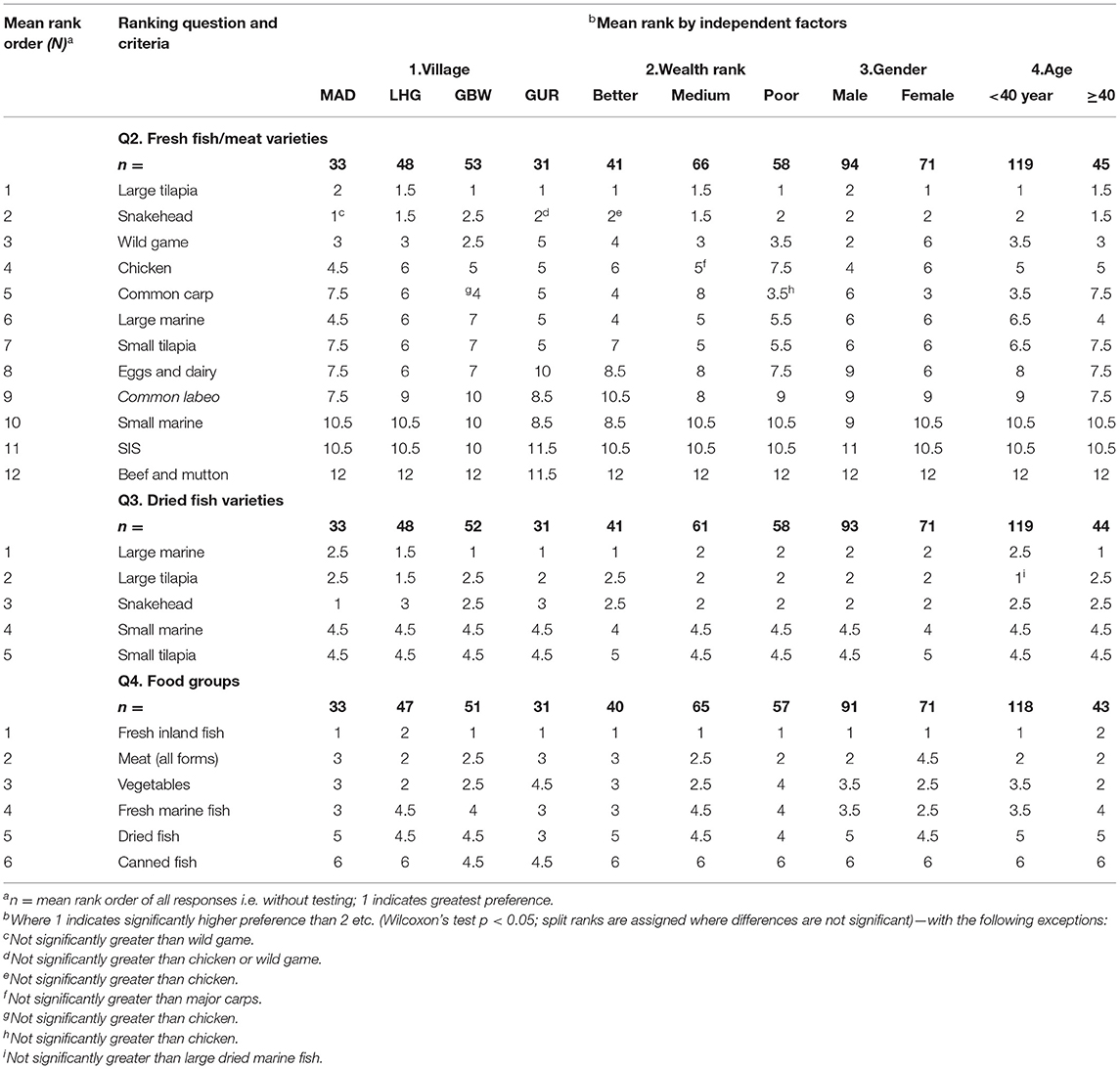
Table 8. Overall ranks from pair-wise tests on preference ranks by independent factors: “village,” “wealth,” “Gender” and “Age” for questions 2, 3 and 4.
Large common carp, relics of historic stocking interventions dating back to 1978 (Petr, 1985), were accorded lower preference than other large inland varieties, but were still favored above all marine and small inland varieties. Females and respondents aged over-forty indicated significantly higher preference for common carp than other groups. This reflected the familiarity of older respondents with formally abundant but, now threatened and rarely available indigenous minor cyprinids (Section Major carps), whilst women pointed to attributes such as ease of preparation, lack of bones linked to their large size and thereby suitability for infants. The trend across wealth groups was inconsistent, possibly due to gender interaction, with both poor and better-off groups ranking exotic carps higher than the medium group.
Normative preference outcomes on question 4; “other food groups” (Table 8) proved highly consistent with results of questions 2 and 3 (positively framed). Considering all respondents Wilcoxon's pair-wise comparisons indicated five significant preference groups (p < 0.05): (1) fresh inland fish was most popular followed by (2) meat (3) vegetables and marine fish, whilst processed forms of (4) dried fish and (5) canned fish were least popular overall (Table 5). The high rank of meat as an aggregate group can be attributed to the popularity of wild game in rural areas. Whilst low preference for beef and mutton was universal, women ranked chicken and wild game considerably lower than men who consume these items as an accompaniment to alcohol. Female preferences also appear to be influenced by their reproductive responsibilities i.e., reflected in their higher preference for common carp (above), eggs and dairy products used to feed children.
Discussion
Methodological Issues
The applied ranking techniques were developed as a quantitative element of a participatory rural appraisal (PRA) toolkit applied in the wider research effort. PRA methods by definition should be adaptable to local contexts (IIED., 1993; Chambers, 1997). In Sri Lanka where basic education standards and literacy levels are high, most respondents were quick to grasp the applied techniques. However, pair-wise ranking with its simple better or worse logic, proved the simplest, quickest and overall, most accurate method. Efficiency also translated into increased sample size and ability to deal with more criteria in Phase 2. Probabilities of achieving at least one Type 1 error ranged from 26.5% (Q1 with 4 criteria) to 99.6% (Q2 with 12 criteria) however, this is unlikely to have had a significant effect on overall outcomes set against the total number of pair-wise tests (Q1 = 6, Q2 = 66). A further shortcoming of the available non-parametric statistical methods is their inability to test for interaction effects, however it was still possible detect major first order effects such as the difference between better-off and poorer women's preferences.
Evaluation of “normative” (aspirational) preferences critical to determination of underlying “wants” is a frequently overlooked element of consumer studies in the development arena, generally more focussed on positive preferences reflecting more pressing immediate “needs” and cost considerations. Akter et al. (2019) study of fish preferences by rural households in Bangladesh is one exception; asking respondents to reflect on their consumption patterns, if food purchasing capacity was not limiting. However, the supplementary nature of the question and lack of any systematic consideration of interaction effects between preference criteria limits the studies inferential power.
Our approach shares elements of the “Theory of Planned Behavior” (TPB) with its emphasis on generalization of behaviors across cultural settings through understanding of subjective attitudes, norms and past experience (Armitage and Conner, 2001; Verbeke and Vackier, 2005; Morales and Higuchi, 2018; Supartini et al., 2018). However, it's application in consumer studies is generally with a view to effecting behavioral change.
Preference Outcomes
Fresh Inland and Marine Fish
So-called “blackfish,” including tilapias, climbing perch and air-breathing snakehead are adapted to survive adverse conditions in residual dry-season pools (Hoggarth et al., 1999a,b). This characteristic also prolongs their post-harvest survival time, an attribute perfectly attuned to the lack of cold-chain capacity in remote rural settings. Covered with a damp cloth in a bicycle back-box such fish reach consumers in a highly fresh, often moribund state. The marked preference for fresh inland fish expressed by all groups in this study corresponds with the high premium placed on the linked attributes of local availability and freshness. Indeed, some respondents characterized the presence of ice, a requirement for most marine fish distribution as an indicator of inferior quality. Similarly, inland fish also loose this attribute when transported to urban markets on ice. This and the challenges for wholesale consolidation of harvests across a geographically and seasonally micro-dispersed production-base explain the persistence of the highly localized rural consumption patterns for reservoir fish observed in the study.
Within their overall rankings, preference for large and small fresh marine fish correlated positively with wealth-status reflecting the sensitivity of poorer consumers to price-differentials with their inland equivalents. In this and a study of three coastal villages near Batticaloa on the east coast, where only fresh marine varieties were readily available (Jabeer et al., 2001), most transactions ranged from 0.5 to 1.5 kg. However only 20.7 and 44.8% of respondents in the coastal villages consumed fresh fish at least once per fortnight and month respectively i.e., less than half the frequency observed in the current study. Marine fish from coastal villages are routinely assembled for distribution to Kandy and Colombo, indicating differences may be in part due to the higher value of marine varieties associated with their urban demand. The authors also report positive correlations between consumption levels and wealth indicators of income, family size and education level.
De Silva (1988) alludes to a greater historic popularity of fresh marine fish in rural areas. Even wider price differentials for marine and (lower cost) inland fish several decades ago (Murray, 2006b) are likely to have been instrumental in building consumer acceptance of the newly introduced tilapias, overcoming strong cultural taboos on inland fish consumption in the process (section Small Indigenous Species and Dried Fish).
Our findings suggest that with the advent of improved cold-chain distribution and purchasing power, demand for marine fish in rural areas may progressively start to emulate urban demand, an assertion underscored by the preference of all groups for dried marine fish above comparably sized dried inland varieties i.e., where “freshness” ceases to be a key determinant.
Small Indigenous Species and Dried Fish
Consumer studies in more affluent markets routinely identify the relative health benefits of fish compared to other protein sources as an inducement for increased consumption (Kaimakoudi et al., 2013; Brouwer and Mosack, 2015; Supartini et al., 2018). Although healthy eating outcomes were not explicitly identified as a purchase attribute in this development context, many studies have demonstrated how wealth-linked preferences can have the positive effect of conserving smaller SIS sometimes referred to as “trash-fish” for poorer consumers. Contrary to this appellation such fish can be of high nutritional value, especially as a source of micronutrients when consumed whole (Thilsted et al., 1997; Bogard et al., 2015a,b; Abeywickrama et al., 2018; Reksten et al., 2020). In a survey of 59 households in rural Mymensingh District, Bangladesh, Roos et al. (2003) reported SIS from wild sources contributed 84% of total fish consumption (while major carps and increasing costly SIS cultured in household ponds are mainly sold for income). The clupeid mola (Amblypharyngodon mola) has its similarly abundant counterpart, A. melattinus in Sri Lanka which, along with other small cyprinids has been identified as a significant but under-exploited biomass in larger reservoirs (De Silva and Sirisena, 1989; Amarasinghe, 1990). However, this ignores the universally low preference for small indigenous species (SIS) evidenced in this study. The marked difference with other regional contexts can be attributed to availability of other substitutes associated with the countries island status.
Despite its abundance of inland and marine resources, Sri Lanka has remained heavily reliant on dried-fish imports from at least the late nineteenth century (Hornell, 1904; De Silva, 1949; Jinadasa, 1977). Our findings confirm dried fish as the single most important source of animal protein for all wealth groups in this survey. Despite a clear normative-aspirational preference for larger fish, the rural poor are the most frequent consumers of smaller cheaper dried varieties, imported mainly from the neighboring States of India, Pakistan and the Maldives. Furthermore, this spares indigenous produce for local consumption in fresh form; dry fish processing being practiced as a salvage-mechanism rather than a value-addition strategy (Murray, 2006a). Smaller, less costly tilapias (<180 g) also fulfill this role, a testament to the unique impact of tilapia introductions on rural food security in the Dry-Zone.
Major Carps
Creech et al. (2001) assessed the potential of exotic carp polycultures for culture-based tank fishery enhancements in Tangalle District in the southern Dry-Zone. They found adverse consumer reaction to bighead carp due to its “excessive oiliness,” but favorable demand and market potential for other varieties including common carp.
This is perhaps unsurprising given the historic consumer familiarity with indigenous minor-cyprinids. Slow but potentially large-growing minor cyprinid species such as Labeo heladiva formally L. dussumieri, colloquially hiri kanaya) and Labeo porcellus were key elements of a lower yielding subsistence fishery prior to the introduction of tilapias. Indeed L. heladiva was marginally more popular with the over-40's group more familiar with this historic context (Section Preference Ranking and Scoring Results). In our study common carp was more popular than all indigenous species except snakehead, took an intermediate position between large tilapia and large marine fish but were not part of everyday diets. Although their large-size is desirable they have relatively poor post-harvest keeping properties and larger fish (5–20 kg) mainly fill a niche demand for festivals and family special occasions (Murray, 2006a).
Cultural Attitudes to Inland Fisheries and Fish Consumption
Our findings show how cultural norms linked to Buddhist religious observance interact with age, wealth gender and caste criteria. Adherence to religious strictures on the taking of life and consumption of fish and meat remain more rigid in Sri Lanka compared to other Theravada Buddhist cultures such as Thailand and Cambodia (Steele and Kaza, 2000; Supartini et al., 2018). Varying degrees of social permissiveness are accorded to different forms of inland fishing and the persistence of such culturally sanctioned norms remained most marked amongst purana communities. Hook and line fishing requiring sacrifice of live-bait was considered especially taboo. Such fishing was of particular importance for subsistence consumption in the lowest caste study village, Maduragama consistent with the highest-ranking preference recorded for snakehead (Table 8). In contrast, economic opportunities arising with the advent of commercial tilapia fisheries in perennial reservoirs have helped foster more permissive attitudes to fisheries participation. However, attitudinal differences toward fish consumption were far less marked across these settings. This was reflected in the generally lower consumption of fish and meat by older Buddhist respondents (>40 yrs), associated with increasing religious observance with age, rather than any intergenerational shift or other socio-economic difference.
Policy Implications
Although not reflected in national statistics or nutrition policy our findings reflect a high dependency on inland fish consumption countering “hidden-hunger” in remoter upper watershed areas. Seasonal substitution of vegetables with low-cost tilapias indicates just how important the inland fishery has become to the food-security as well as the income of a sizeable proportion of the rural poor. Thus, the demarcation between rural and urban demand for inland fish should be a central policy consideration in a rural food security and vulnerability context.
Despite policy short-comings, results point to the inherent resilience of the inland tilapia fishery in particular. De Silva (1987) estimated the fisheries yield of 18 major reservoirs to average 224 kg/ha/year, one of the highest natural productivity levels of any reservoir fishery globally. Kolding et al. (2016) document similarly resilient fisheries in seasonal dry-land water bodies of Sub-Saharan Africa.
Conditions of near perfect competition associated with the highly localized nature of inland fish supply and demand in Sri Lanka, result in equitable distribution of benefits from the dominant tilapia fishery to numerous small-scale actors along the value-chain. Low barriers to entry and exit for producers and retail vendors alike are associated with low input costs for fishing and distribution, the absence of any market knowledge asymmetries and concomitant lack of wholesale opportunities for middlemen assemblers. Strong demand and supply characteristics for a uniformly high quality and fresh low-cost commodity, are underpinned by resilient fisheries and the excellent post-harvest keeping properties of tilapias in the absence of cold-chain facilities.
Logically, this context should provide the reference-point for any policy discussion on poverty-focussed inland aquaculture development. However various factors have contributed to policy and associated development short-comings: (i) firstly the incremental consumer acceptance of tilapia over many decades and the rural-urban demarcation of demand for inland fish underpins a poor appreciation of supply and demand fundamentals (ii) the serendipitous nature of tilapia introductions and the minimal requirement for State intervention post-establishment of this self-recruiting fishery (iii) political conflicts of interest; the State has wavered between passive resistance and support to the inland fisheries sector in response to the lobbying of interest groups threatened by the emergence of the tilapia fishery. This resulted in the withdrawal of all financial support to the sector between 1989 and 1994 (Peter, 1998) (iv) in the longer term the lure of international development grants and soft-loans has fuelled the historic promotion of culture-based stocking-enhancements based on Indian and Chinese major carp species (MOFARD, 1995; Amarasinghe, 1998; Ahmed, 2002; Intrafish, 2011; NARA, 2016; Chandrasoma and Pushpalatha, 2018). Based on an analysis of retail price indices between 1980 and 2001, Murray et al. (2000) demonstrated how demand and supply for inland fish remained relatively well matched as population density in Puttalam and Kurunegala Districts (NWP) rose by 21 and 45%, respectively. Since implementation of the survey work in 2003, growth slowed to 10 and 13% between 2001 and 2019 to reach 271 and 357 persons/km2 and the proportion of the population with Sinhalese ethnicity rose from 82 to 86% (DCS., 2003, DCS, 2019), whilst nationally, annual per capita fish consumption rose by 41% from 22.3 to 31.4 kg between 2001 and 2016 (FAO, 2019). At the same time recorded inland capture production nearly trebled, from 26,330 mt in 2001 to 87,690 mt in 2018 (NARA, 2016; FAO, 2019) whilst freshwater aquaculture production was estimated to have risen from 1,620 to 29,042 mt between 2004 and 2018 (FAO, 2019). Meanwhile, marine capture production, the principal substitute for inland fish, nearly doubled from 240,722 mt in 2001 to 451,958 mt in 2018 when the country became a net seafood importer for the first time since 1998. Despite data constraints (Chandrasoma and Pushpalatha, 2018), the significance of inland capture endowments to rural livelihood remains clear; at just USD 1.3/kg, Funge-Smith and Bennett (2019) estimated Sri Lanka to have the third lowest average price for bony inland fish in a global survey of inland fisheries in 28 countries and regions, with 95% of such production recorded in developing countries.
Consequently, development initiatives focussed on increasing urban and/or export demand for inland fish should be approached on a precautionary basis. Furthermore, culture-based stocking enhancements in seasonal or perennial tanks that fail to properly account for the economic resilience of the dominant self-recruiting tilapia fishery are unlikely to be sustainable without on-going government subsidy. Weak inter-disciplinary contextualization of these complex human ecosystems at appropriate system scales appears to be at the root of historic policy failures. Our findings are highly consistent with other cited studies and reviews highlighting under reporting and failure of traditional economic analysis to account for the importance of inland fisheries across multiple livelihood and food security dimensions (Garaway et al., 2013; Funge-Smith and Bennett, 2019; Kolding et al., 2019). Finally, the study confirms the critical role for household consumption and preference survey techniques in data-deficient settings (Fluet-Chouinard et al., 2018; Funge-Smith and Bennett, 2019; Garaway and Arthur, 2019). Results also demonstrate how understanding of motivations underlying consumer demand, and inferential power can be augmented through a synergistic framing of positive and normative preference questions. Such differentiation is particularly critical in transitional livelihood and nutrition contexts.
Data Availability Statement
The raw data supporting the conclusions of this article will be made available by the authors, without undue reservation.
Ethics Statement
Ethical review and approval was not required for the study on human participants in accordance with the local legislation and institutional requirements. Written informed consent for participation was not required for this study in accordance with the national legislation and the institutional requirements.
Author Contributions
FM and DL conceptualized the study and oversaw results. FM collected and analyzed data, drafted the manuscript, and responded to review comments. Both authors reviewed and edited the manuscript, and contributed to the article and approved the submitted version.
Funding
This study was part of a collaborative 4-year research project (1999–2003) funded by CARE International and the UK Department for International Development (DFID, Grant Number R7064), researching potential for poverty focussed inland aquaculture in the Dry-Zone of Sri Lanka.
Conflict of Interest
The authors declare that the research was conducted in the absence of any commercial or financial relationships that could be construed as a potential conflict of interest.
Publisher's Note
All claims expressed in this article are solely those of the authors and do not necessarily represent those of their affiliated organizations, or those of the publisher, the editors and the reviewers. Any product that may be evaluated in this article, or claim that may be made by its manufacturer, is not guaranteed or endorsed by the publisher.
Acknowledgments
FM and DL are members of the Sustainable Seafood Consumption Initiative, an international, interdisciplinary collective based at Stirling. We also acknowledge contributions of Yasanthe Naveratne, Priyantha Jayakody, Bandara Samarakoon and Buddhika Karunarathna of the University of Peradeniya in testing and implementation of survey instruments.
References
Abeywickrama, H. M., Koyama, Y., Uchiyama, M., Shimizu, U., Iwasa, Y., Yamada, E., et al. (2018). Micronutrient status in Sri Lanka: a review. Nutrients. 10, 11. doi: 10.3390/nu10111583
Ahmed, M. (2002). Progress report on the stocking of small tanks in Anuradhapura District as part of the CARE Dry-Zone Agriculture Project (DZAP). Unpublished report.
Akter, R., Thilsted, S. H., Hossain, N., Ishihara, H., and Yagi, N. (2019). Fish is the preferred animal-source food in the rural community of Southern Bangladesh. Sustainability 11, 5764. doi: 10.3390/su11205764
Amarasinghe, U. S. (1990). Minor cyprinid resources in a man-made lake in Sri Lanka: a potential supplementary source of income for fishermen. Fisher. Res. 9, 81–89. doi: 10.1016/0165-7836(90)90043-U
Amarasinghe, U. (1998). How effective are the stocking strategies for the management of reservoir fisheries in Sri Lanka. Edited by I. Cowx.
Armitage, C. J., and Conner, M. (2001). Efficacy of the theory of planned behaviour: a meta-analytic review. Br. J. Soc. Psychol. 40, 471–499. doi: 10.1348/014466601164939
Bogard, J. R., Hother, A. L., Saha, M., Bose, S., Kabir, H., and Marks, G. C. (2015a). Inclusion of small indigenous fish improves nutritional quality during the first 1000 days. Food Nutr. Bull. 15, 1–14. doi: 10.1177/0379572115598885
Bogard, J. R., Thilsted, S. H., Marks, G. C., and Wahab, M. A. (2015b). Nutrient composition of important fish species in Bangladesh and potential contribution to recommended nutrient intakes. J. Food Comp. Anal. 42, 120–133 doi: 10.1016/j.jfca.2015.03.002
Brouwer, A. M., and Mosack, K. E. (2015). Expanding the theory of planned behavior to predict healthy eating behaviors: exploring a healthy eater identity. Nutr. Food Sci. 45, 39–53. doi: 10.1108/NFS-06-2014-0055
Chambers, R. (1997). Whose Reality Counts? Putting the first Last. London: Intermediate Technology Publications. doi: 10.3362/9781780440453
Chandrasoma, J., and Pushpalatha, C. K. B. (2018). Fisheries enhancements in inland waters in Sri Lanka with special reference to culture based fisheries: current status and impacts. Sri Lanka. J. Aquat. Sci. 23, 49–65. doi: 10.4038/sljas.v23i1.7546
Creech, S., Desanayake, L., and Weerasinghe, J. (2001). Impact assessment of the first years stocking programme 1999–2000. Fisheries and aquaculture programme report 1999-2001. Nugegoda: Sewa Lanka Foundation.
Creswell, J. W. (2014). Research Design; Qualitative, Quantitative and Mixed-Methods Approaches. London: Sage Publications Ltd., p. 273.
DCS (2019). Department of Census and Statistics, Sri Lanka (web). Available online at: https://www.citypopulation.de/php/srilanka-prov-admin.php?adm2id=62
DCS. (2003). Population and Housing Censuses in Sri Lanka. Colombo, Sri Lanka: Department of Census and Statistics. Available online at: http://www.statistics.gov.lk/page.asp?page=Publications
De Silva, S. F. (1949). “The southwest country,” in A regional geography of Ceylon. Colombo: The Colombo Apothecaries Company Ltd. pp. 129–132.
De Silva, S. S., and Sirisena, H. K. G. (1989). New fish resources of reservoirs in Sri Lanka. 3. Results of commercial-scale trials and yield estimates of a gill-net fishery for minor cyprinids Fisheries Res. 7, 279–287. doi: 10.1016/0165-7836(89)90061-1
FAO (1995). Regional symposium on sustainable development of inland fisheries under environmental constraints. Bangkok: FAO Rome.
FAO (2019). Fishery and Aquaculture Country Profiles. The Democratic Socialist Republic of Sri Lanka. Available online at: http://www.fao.org/fishery/facp/LKA/en
Fluet-Chouinard, E., Funge-Smith, S., and McIntyre, P. B. (2018). Global hidden harvest of freshwater fish revealed by household surveys. PNAS. 115, 7623–7628. doi: 10.1073/pnas.1721097115
Funge-Smith, S., and Bennett, A. (2019). A fresh look at inland fisheries and their role in food security and livelihoods. Fish Fisher. doi: 10.1111/faf.12403
Garaway, C. J., and Arthur, R. (2019). Measuring fish catch and consumption: Practical methods for small-scale fisheries based on length as an alternative to weight-based approaches. Fisher. Manage. Ecol. 27, 270–278. doi: 10.1111/fme.12409
Garaway, C. J., Photitay, C., Roger, K., Khamsivilay, L., and Halwart, M. (2013). Biodiversity and nutrition in rice-based ecosystems; the case of Lao PDR. Hum. Ecol. 41, 547–562. doi: 10.1007/s10745-013-9602-z
Gosling, L., and Edwards, M.. (1995). Toolkits: A Practical Guide to Assessment, Monitoring, Review and Evaluation. London: Save the Children.
Hoggarth, D. D., Cowan, V. J., Halls, A. S., Aeron-Thomas, M., McGregor, J. A., Garaway, C. A., et al. (1999a). Management guidelines for Asian floodplain river fisheries. Part 2: Summary of DFID research FAO Fisheries Technical Paper. No. 384/2. FAO: Rome, p. 117.
Hoggarth, D. D., Dam, R. K., Debnath, K., and Halls, A. S. (1999b). Recruitment sources for fish stocks inside a floodplain river impoundment in Bangladesh. Fisher. Manage. Ecol. 6, 287–310. doi: 10.1111/j.1365-2400.1999.tb00081.x
IIED. (1993). Training notes on participatory rural appraisal for village planning: A training workshop for the Self-Help Support Programme—Interco-operation Sri Lanka Hambantota, Sri Lanka, August. Sustainable Agriculture Programme, International Institute for Environment and Development. p. 236.
Intrafish (2011). Sri Lanka diving into aquaculture. Available online at: https://www.intrafish.com/news/sri-lanka-diving-into-aquaculture/1-1-631363
Jabeer, A. A., H. S. R., Rosario, and Ahmed, A. N.. (2001). A study on consumer behaviour patterns in fish marketing in Boralanda /Welimada area in Sri Lanka. AGRIEAST, in press.
Jinadasa, J. (1977). “Fisheries,” in: Arunjas atlas of Sri Lanka, ed T. Somasekaram (Colombo: Arunja Consulting Company), pp. 113–117.
Kaimakoudi, E., Polymeros, K., and Schinaraki, M. G. (2013). Batzios C. consumers' attitudes towards fisheries products. Proc. Technol. 8, 90–96. doi: 10.1016/j.protcy.2013.11.013
Kodithuwakku, S. S. (1997). Entrepreneurial Processes in an Apparently Uniform Context: A Study of Rural Farmers in Sri Lanka. PhD Thesis Stirling University, UK.
Kolding, J., Van Zwieten, P., Martin, F., Funge-Smith, S., and Poulain, F. (2019). Freshwater small pelagic fish and fisheries in major African lakes and reservoirs in relation to food security and nutrition. FAO Fisheries and Aquaculture Technical Paper No. 642. Rome, FAO. 124 pp. FAO. Licence: CC BY-NC-SA 3.0 IGO.
Kolding, J., Van Zwieten, P., Martin, F., and Poulain, F. (2016). Fisheries in the drylands of sub-saharan Africa “fish come with the rains” Building resilience for fisheries-dependent livelihoods to enhance food security and nutrition in the drylands. Rome: FAO Fisheries and Aquaculture Circular No.1118 FIAF/FIAP/C1118 (En)
Little, D. C., Murray, F. J., Leschen, W., and Waley, D. (2013). Socio-economic factors affecting aquaculture site selection and carrying capacity. Expert Workshop on Site Selection and Carrying Capacities for Inland and Coastal Aquaculture, Institute of Aquaculture, University of Stirling, the United Kingdom of Great Britain and Northern Ireland, 6-8 December (2010). Bulletin article; Conference paper: FAO Fisheries and Aquaculture Proceedings2013 No.21 pp.103-115 ref.41
Maxwell, S., and Bart, C. (1995). Beyond Ranking: Exploring relative preferences in P/RRA. London: PLA Notes 22, 28–35.
Messick, S. (1995). Validity of psychological assessment: validation of inferences from persons' responses and performances as scientific inquiry into score meaning. Am. Psychol. 50, 741–749. doi: 10.1037/0003-066X.50.9.741
MOFARD (1995). National fisheries development plan 1995-2000. Ministry of fisheries and aquatic resources development. Colombo: Maligawatta, p. 10.
Morales, L. E., and Higuchi, A. (2018). Is fish worth more than meat?—How consumers' beliefs about health and nutrition affect their willingness to pay more for fish than meat. Food Qual. Preferen. 65, 101–109. doi: 10.1016/j.foodqual.2017.11.004
Murray, F. J. (2004). Potential for aquaculture in community-managed irrigation systems of the Dry-Zone, Sri Lanka: Impacts on livelihoods of the poor. PhD Thesis Stirling University, UK.
Murray, F. J. (2006a). “The marketing context—Understanding demand for fish: Studies that are to be undertaken and considered prior to popularising culture-based fisheries practices,” in Better-Practice Approaches for Culture-Based Fisheries Development in Asia, eds. De Silva, S.S., Amarasinghe, U.S., Nguyen, T.T. ACIAR Monograph No 120 96p.
Murray, F. J. (2006b). “When Co-management fails: a review of theory and lessons learned from reservoir fisheries in the dry-zone of Sri Lanka,” in CBFM-2 International conference on community-based approaches to fisheries management. Hotel Radisson, Dhaka, Bangladesh, 6-7 Mar 2007. Conference Paper, eds Dickson, M. M., and Brooks, A. Dhaka, Bangladesh: WorldFish Center. Available online at: http://www.worldfishcenter.org/resource_centre/WF_37455.pdf
Murray, F. J., and Little, D. C. (2000). Fisheries Marketing Systems and Consumer Preferences in Puttalam District Sri-Lanka. Stirling University, Institute of Aquaculture. Department for International Development (DFID) Aquaculture Research Program (ARP) Project 7064.
Murray, F. J., Little, D. C., and Koddithuwakku, S. S. (2000). “Fisheries marketing systems in Sri Lanka and their relevance to local reservoir fishery development. Reservoir and culture-based Fisheries: biology and management,” in ACIAR proceedings No. 98. De Silva, S (Ed).
NARA (2016). Fisheries Industry Outlook. Socio-Economic and Marketing Research Division. National Aquatic Resources Research and Development Agency (NARA). Available online at: http://www.nara.ac.lk/wp-content/uploads/2017/09/2016-Fisheries-Outlook-2018.01.18-new.pdf
Needham, S., and Funge-Smith, S. J. (2014). The Consumption of Fish and Fish Products in the Asia-pacific Region Based on Household Surveys. Bangkok: RAP Publication, p. 87.
Petr, T. (ed.). (1985). Inland fisheries in multi-purpose river basin planning and development in tropical Asian countries: Three case studies. FAO Fish. Tech. Pap. 265:166
Reksten, A. M., Somasundaram, T., Kjellevold, M., Nordhagen, A., Bøkevoll, A., Pincus, L. M., et al. (2020). Nutrient composition of 19 fish species from Sri Lanka and potential contribution to food and nutrition security. J. Food Composit. Anal. 91, 103508. doi: 10.1016/j.jfca.2020.103508
Renzella, J., Fernando, S., Kalupahana, B., Scarborough, P., Rayner, M., and Townsend, N. (2020). Food labour, consumption hierarchies, and diet decision-making in Sri Lankan households: a qualitative study. BMC Nutri. 6, 64. doi: 10.1186/s40795-020-00389-w
Roos, N., Islam, M. M., and Thilsted, S. H. (2003). Small indigenous Fish species in Bangladesh: Contribution to vitamin A, calcium and iron intakes. J. Nutri. 11, 4021-4026 doi: 10.1093/jn/133.11.4021S
Sakthivadivel, R., Fernando, H., and Brewer, J. (1997). Rehabilitation planning for small tanks in cascades: A methodology based on rapid assessment. Colombo: International Water Management Institute (IWMI).
Sathiadas, M. G., Antonyraja, A., Viswalingam, A., Thangaraja, K., and Wickramasinghe, V. P. (2021). Nutritional status of school children living in Northern part of Sri Lanka. BMC Pediatric. 21, 43. doi: 10.1186/s12887-021-02501-w
Steele, K., and Kaza, S. (2000). Buddhist food practices and attitudes among contemporary western practitioners. Ecotheology 9, 49–67. doi: 10.1558/ecotheology.v5i2.49
Supartini, A., Oishi, T., and Yagi, N. (2018). Changes in fish consumption desire and its factors: a comparison between the United Kingdom and Singapore. Foods. 7, 97. doi: 10.3390/foods7070097
Thilsted, S. H., Roos, N., and Hassan, N. (1997). The role of small indigenous fish species in food and nutrition security in Bangladesh. NAGA. 20, 82–84.
Verbeke, W., and Vackier, I. (2005). Individual determinants of fish consumption: application of the theory of planned behavior. Appetite. 44, 67–82 doi: 10.1016/j.appet.2004.08.006
Weerahewa, J., Gedara, P. K., and Wijetunga, C. S. (2018). Nutrition transition in Sri Lanka: a diagnosis. Annal. Nutri. Food Sci. 2:1020. Available online at: http://www.remedypublications.com/annals-of-nutrition-food-science-abstract.php?aid=286
WFP (2017). WFP Sri Lanka Country Strategic Plan (2018-2022). Available online at: https://documents.wfp.org/stellent/groups/public/documents/eb/wfp293168.pdf Google Scholar
Keywords: seafood marketing, reservoir fisheries, food security, nutrition, tilapia, cultural attitudes, value chains of staple food, consumer preference analysis
Citation: Murray FJ and Little DC (2022) Rural Consumer Preferences for Inland Fish and Their Substitutes in the Dry-Zone of Sri Lanka and Implications for Aquaculture Development. Front. Sustain. Food Syst. 6:867701. doi: 10.3389/fsufs.2022.867701
Received: 01 February 2022; Accepted: 16 March 2022;
Published: 14 April 2022.
Edited by:
Erick Ochieng Ogello, Maseno University, KenyaReviewed by:
Asankha Pallegedara, Wayamba University of Sri Lanka, Sri LankaMichael Fabinyi, University of Technology Sydney, Australia
Copyright © 2022 Murray and Little. This is an open-access article distributed under the terms of the Creative Commons Attribution License (CC BY). The use, distribution or reproduction in other forums is permitted, provided the original author(s) and the copyright owner(s) are credited and that the original publication in this journal is cited, in accordance with accepted academic practice. No use, distribution or reproduction is permitted which does not comply with these terms.
*Correspondence: Francis Joseph Murray, ZnJhbmNpc211cnJheTY1QGdtYWlsLmNvbQ==; orcid.org/0000-0002-0187-1380
 Francis Joseph Murray
Francis Joseph Murray David Colin Little
David Colin Little